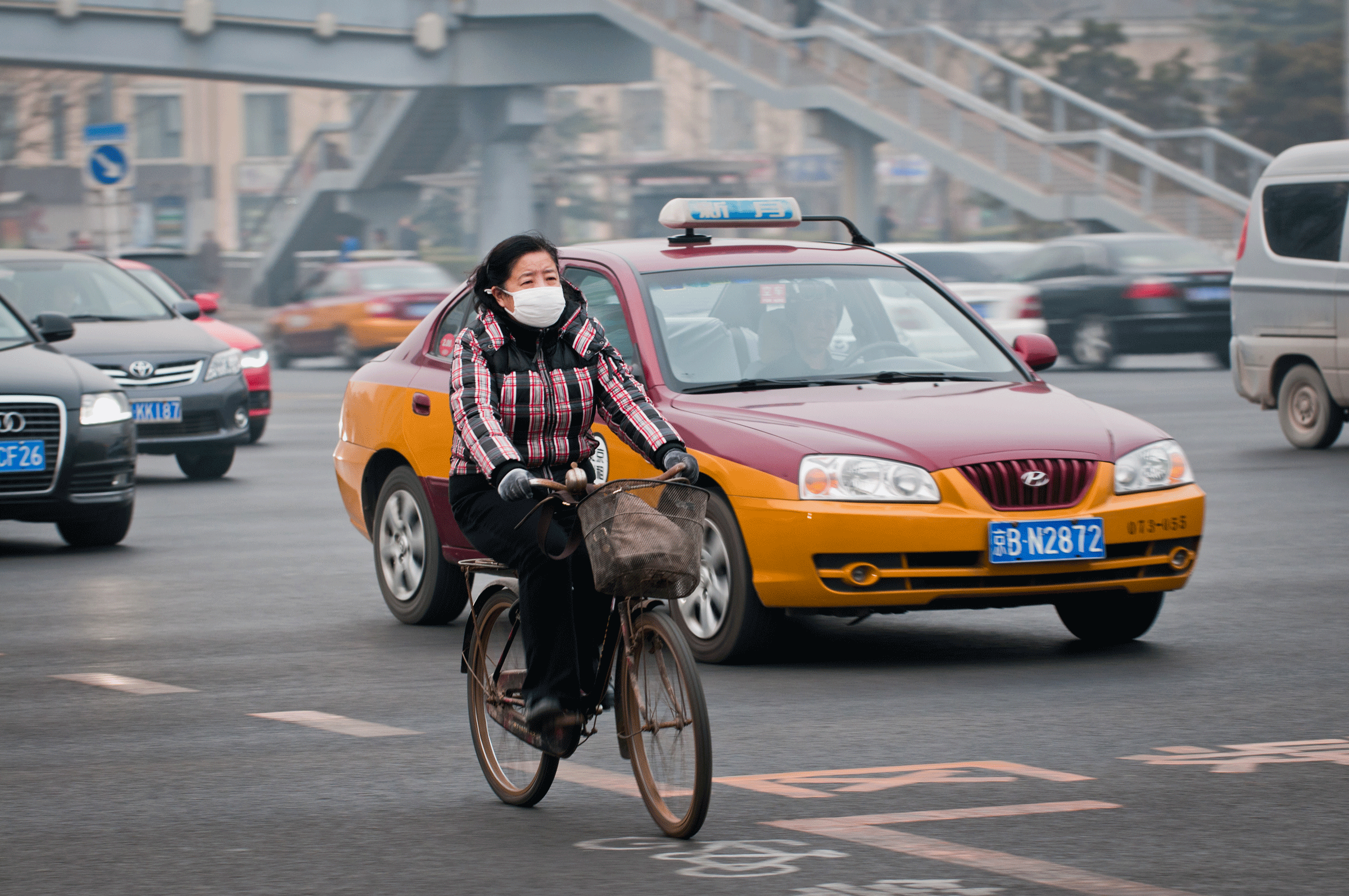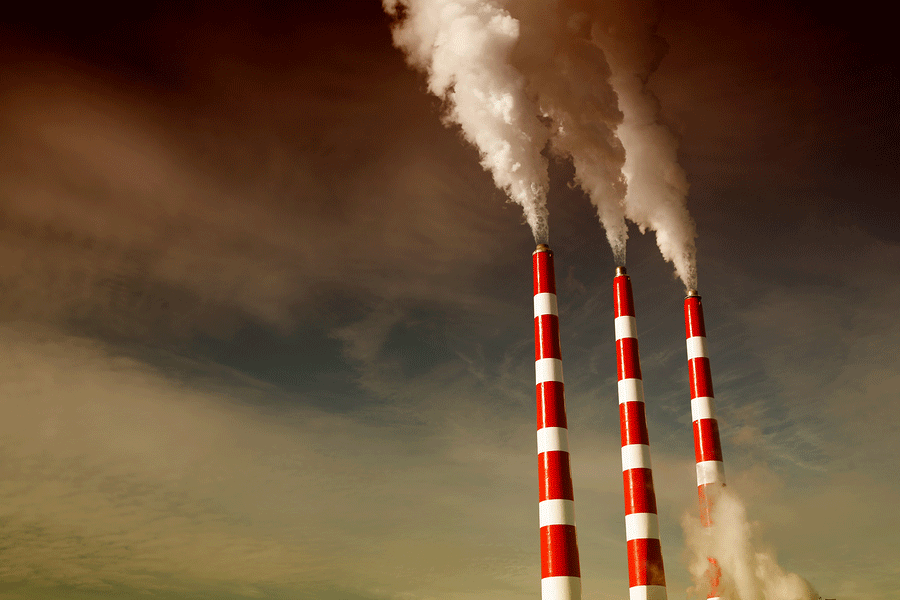Ozone Pollution on the Rise
Air Date: Week of May 2, 2014

Air pollution in the United States isn’t as bad as China, but in recent years we’ve seen an increase in ozone pollution (photo: bigstockphoto.com)
The American Lung Association puts out an annual report on the state of air quality in the United States. Though the air overall is getting cleaner, Janice Nolen of the Lung Association tells host Steve Curwood this year's report shows a growing ground level ozone problem. Still, a recent Supreme Court decision has clean air advocates feeling optimistic.
Transcript
CURWOOD: It's Living on Earth, I'm Steve Curwood. Every year the American Lung Association puts out a State of the Air report. And since the Clean Air Act became law, the nation's air has gotten cleaner, and increasingly regulations on vehicles and power plants have helped cement the gains, but there's still plenty of room for improvement. Janice Nolen is the Assistant Vice President of National Policy and Advocacy for the Lung Association, and one of the authors of the report.
She says there's definitely some good news, but with the planet getting hotter we won’t all be able to breathe easy.
NOLEN: We're actually doing better in particle pollution, year-round particle pollution levels, but we have much ozone spread around the nation. A hot summer in 2012 meant that our ozone levels went up for much of the nation, and as a result, we have more people who are breathing unhealthy air than in our previous report.
CURWOOD: How does climate change make ozone worse, if it does?
NOLEN: It does. As we get warmer temperatures, the raw ingredients that create ozone cook better. The raw ingredients, the gases, volatile organic compounds, nitrogen oxide and carbon monoxide come from those smoke stacks and tailpipes and they cook in sunlight, and heat makes that cook better. So when we’re trying to deal with ozone by having to have that heat, it makes for a much more receptive area for the ozone to form. And with carbon pollution, carbon pollution adds to that temperature, it adds to that heat. And so, as we can reduce the carbon pollution, we’re going to have a better shot at being able to reduce the ozone overall.
CURWOOD: What are the health impacts of ozone?

Air pollution is a major health risk, particularly for children and the elderly (photo: bigstockphoto.com)
NOLEN: Ozone is a highly irritating gas. It irritates the lungs as if you had a sunburn or if somebody was rubbing sandpaper over a wound. And what that ultimately does is cause things like asthma attacks, coughing and wheezing. It can send people to the hospital and the emergency room. It can even shorten lives, and now we’re learning that it may have things that have more unusual impacts that we hadn’t appreciated, like increasing the risk of having a low birthweight in a newborn baby, so the more we’re learning about these pollutants, especially about ozones, the more harm we’re finding as a result of that. Particle pollution is even more serious. The particle pollution that we’ve been reducing is extremely lethal. It can cause heart attacks and stroke, it can also increase the risk of lung cancer.
CURWOOD: Geographically, where is ozone pollution really bad?
NOLEN: In most all of the country. We have a lot of areas in the big cities, urban areas, and in places where we’re seeing a lot of extraction in oil and gas where we’re seeing a lot of the raw ingredients for ozone being created. So we’re seeing some places that hadn’t had ozone problems before, having them. Lots of the country where it’s warmer, sunnier, where the raw ingredients can cook well and create it. So, a big part of the middle part of the country.
CURWOOD: What cities are the worst?
NOLEN: The worst for ozone are a lot of the California cities. Los Angeles has been number one on our list of most polluted cities for a long, long time. And we also have cities like Bakersfield, Fresno, Sacramento, but after you get out of the California area: Houston, Dallas, Washington DC, Las Vegas - all of those are among our 10 most polluted cities for ozone.
CURWOOD: In terms of ozone, what particular populations of people are at risk, and is that income related at all?

Janice Nolen (photo: American Lung Association)
NOLEN: In some ways, actually both ozone and particle pollution affect some of the same people. People who are children or teenagers because your lungs keep growing until you’re 18 years of age. People who are over 65. People who have chronic lung disease, chronic heart disease, people with diabetes, people who are healthy adults who exercise or work outdoors. And also, low-income people. Those people, for many reasons, are folks who have some of the highest impacts and are most vulnerable from pollution of all sources.
CURWOOD: From a policy perspective, what needs to be done then to address the ozone problem?
NOLEN: We need to have a tighter ozone standard. The EPA is looking at the science right now, and they are required to review this every five years in order to make sure the goal that we’re setting, the official standard for ozone, is right. And what we know is that it’s not, that there’s more pollution in the air, and that the levels that are much lower in ozone actually are harmful, and so we need to strengthen that standard, and that’s going on right now, and that will help us better prepare for the future because it will help us aim at the right goal for cleaning up pollution.
CURWOOD: Now, the Supreme Court recently made a big decision when it comes to air quality on something called the “cross-state” rule. Tell us about it, why you think its important.
NOLEN: We were really pleased with the Supreme Court decision about the “cross-state rule” because it’s based in a part of the Clean Air Act they call the “good neighbor rule”, and that means that polluters that are in another state are not allowed to produce pollution that blows into a downwind state and causes unhealthy air. EPA has been trying to deal with that because the states haven’t regulated themselves adequately, and so EPA provided some rules on how to reduce that. And that was challenged all the way to the Supreme Court, and the Supreme Court said absolutely, this is a provision that needs to be upheld, EPA has done a good job at trying to figure that out, and we need to make sure that pollution isn’t blown across the state line. For example, in Maryland, where they found that so much of pollution in Maryland is blown in from out of state that they really can’t meet their goal for cleaning up the air without having some help from the federal government. And the Supreme Court allowed that to happen.
CURWOOD: What kind of legal precedent does this set for the rest of President Obama’s efforts to regulate carbon pollution under the Clean Air Act?
NOLEN: What we’re hoping is that it shows that EPA can do these kinds of detailed analyses and establish rules that recognize that air flows everywhere, and carbon pollution is just like that, and that you have to control these big sources, and often those big sources are away from some of the places where the pollution is having the biggest impact. So we’re optimistic that this shows that looking at the Clean Air Act, which is, by the way, over 40 years old, establish these kinds of processes that once they’re allowed to work can really help make a difference. So we’re optimistic that the carbon pollution standard will be able to help EPA take the tools that they need to address this big source of climate change.
CURWOOD: Janice Nolen is the Assistant Vice President of National Policy and Advocacy for the American Lung Association. Thanks so much for taking this time with us.
NOLEN: Thank you so much. Take care.
Links
Living on Earth wants to hear from you!
Living on Earth
62 Calef Highway, Suite 212
Lee, NH 03861
Telephone: 617-287-4121
E-mail: comments@loe.org
Newsletter [Click here]
Donate to Living on Earth!
Living on Earth is an independent media program and relies entirely on contributions from listeners and institutions supporting public service. Please donate now to preserve an independent environmental voice.
NewsletterLiving on Earth offers a weekly delivery of the show's rundown to your mailbox. Sign up for our newsletter today!
 Sailors For The Sea: Be the change you want to sea.
Sailors For The Sea: Be the change you want to sea.
 The Grantham Foundation for the Protection of the Environment: Committed to protecting and improving the health of the global environment.
The Grantham Foundation for the Protection of the Environment: Committed to protecting and improving the health of the global environment.
 Contribute to Living on Earth and receive, as our gift to you, an archival print of one of Mark Seth Lender's extraordinary wildlife photographs. Follow the link to see Mark's current collection of photographs.
Contribute to Living on Earth and receive, as our gift to you, an archival print of one of Mark Seth Lender's extraordinary wildlife photographs. Follow the link to see Mark's current collection of photographs.
 Buy a signed copy of Mark Seth Lender's book Smeagull the Seagull & support Living on Earth
Buy a signed copy of Mark Seth Lender's book Smeagull the Seagull & support Living on Earth

